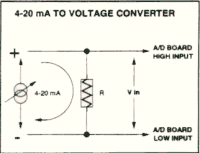 |
Measuring a 4-20ma Input With a Voltage Input DeviceIt is extremely simple and inexpensive to measure 4-20ma with a device that will measure only Voltage. Most A/D boards will accept a 0-5Vdc signal, but may not accept a 4-20ma signal directly. The solution to this problem will only take a few minutes and a few dollars. Basically, Ohms law is used to calculate a resistor value in order to convert the 4-20ma to a voltage. The most popular resistor value for this purpose is 250 Ohms, since it will produce a 1-5Vdc signal when 4-20ma flows through it, and a 0-5Vdc input is very common for most data acquisition systems and other analog measurement devices. However, there are cases where voltage inputs other than 0-5Vdc are desired, so the following example will demonstrate how simple it is to calculate the correct value resistor for any voltage input. ------------------------------------------------------------------- For this example, we will assume that a 0-2 Vdc input will be used to measure 4-20ma. Ohms law states: R=V/I where V is the Voltage, I is the current and R is the resistance R=2V/.020A = 100 Ohms When 20ma flows through a 100 Ohm resistor, it will drop 2 volts When 4ma flows through a 100 Ohm resistor, it will drop 0.4 volts Therefore, 4-20ma through a 100 ohm resister will drop 0.4 to 2 volts One more important thing to remember is that the resistor tolerance should be 1% or less; preferrably 0.1%, since errors in the resistance will result in errors in the voltage drop. You don't want a resister that fluctuates much with time or temperature, as it will effect your accuracy. After you have selected a resistor value, you must verify your readings and make any fine tuning adjustments in your software to compensate for any errors in the resistor. For example, a 100 ohm resistance may actually be 99.5 ohms, therefore your voltage output will actually be 0.398 to 1.99Vand not 0.4 to 2V as we calculated. You simply connect the resistor across the voltage input terminals for your data acquisition system, and then connect your 4-20ma signal to the same two terminals, so that as the current flows through the resistor, a voltage will be dropped and then measured by the data acquisition device. Keep in mind that it may be necessary to ground the power supply if you are using it to power a transmitter or 2 wire sensor. The following diagram will illustrate this
|

